 Abraham Lincoln
If given the truth, the people can be depended upon to meet any national crisis...
Abraham Lincoln
If given the truth, the people can be depended upon to meet any national crisis...
 Guildford news...
for Guildford people, brought to you by Guildford reporters - Guildford's own news service
Guildford news...
for Guildford people, brought to you by Guildford reporters - Guildford's own news service
Searching for Guildford’s Earliest Picture Postcards
Published on: 23 Aug, 2023
Updated on: 26 Aug, 2023
By David Rose
Vintage picture postcards that feature views of cities, towns and villages give a fantastic window into yesterday’s world.
Known as topographic postcards, it’s reckoned that 800 million a year were being used by about 1910. They were the fast form of communication of the era and most places in Britain enjoyed up to three postal collections and deliveries a day!
The period from the early 1900s to a time just after the First World War is often called the Golden Age of the picture postcard.
With not only topographic views produced in their many thousands, subjects also illustrated on postcards featured everything (and as far ranging) from cats to lighthouses and trains to saucy seaside and comic cards.
So when were views of Guildford first published on postcards? Before I offer some suggestions with examples, a bit about the history of the humble postcard, that, incidentally, arrived much later than the evolution of Britain’s postal service.
Henry VIII created the Royal Mail in 1516, and Charles II appointed the first postmaster general, Henry Bishop, in 1661. Rowland Hill championed the Great Postal Reforms of 1839-40 and is credited with the introduction of the postage stamp.
However it was in 1869 that Austria-Hungary issued the first postcards – an open card that could be used to send a short message, at a concessionary postal rate.
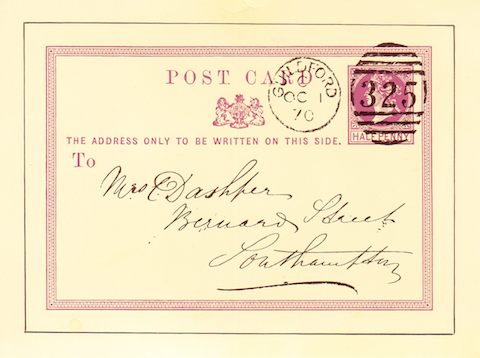
A British postcard purchased from Guildford post office and sent from Guildford to Southampton on the very first day of issue of these new forms of communication – October 1, 1870. Note the cancellation mark – 325. This confirmed the postage had been paid. The number refers to Guildford’s post office.
Britain followed in 1870, with its postcards pre-printed with a halfpenny stamp, with the address only to be written on that side with the other being reserved for a message. They did not have illustrations or photographs and could only be purchased at post offices.

The message on the back of the above postcard reads: “Having written you this afternoon I have not much to tell you now. I send you a card the first day of course for novelties, it being a new thing of course the Post Office people will read them, after a while they will not take the trouble to read love letters even”.
I think it’s amazing that this first type of postcard, bought and sent from Guildford on the first day of issue, October 1, 1870, exists and the message really is a piece of postal history!
I was fortunate to be able to make a copy of both sides of the card, from two 35mm slides images, and then reproduced it in my book Memory Lane Guildford & District, published by Breedon Books in 2000. It had been owned by the now late Peter Bullen of Guildford, who was a postcard collector and dealer. He sold it, and I would be interested to know who owns the original card now.
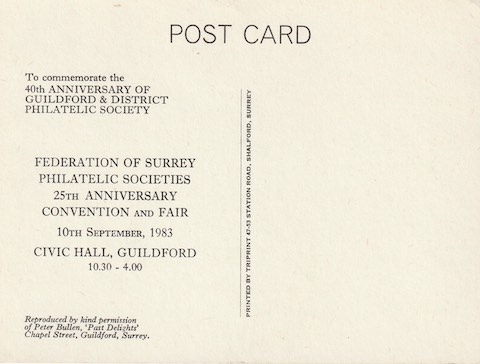
The back of the reproduced postcard, issued in 1983 to commemorate the 40th anniversary of the Guildford & District Philatelic Society.
In fact, in 1983 the address and fixed stamp side of that postcard was reproduced as a card to commemorate the 40th anniversary of the Guildford & District Philatelic Society.
The early postcards were an instant hit, and it’s said that in 1871 around 75 million postcards were sent in Britain.
It was not until 1894 that postcards were allowed to which a stamp could be affixed and images allowed, produced by private publishers, were permitted. However, one side was still reserved to write the address of the recipient, while the other side contained the image(s) and the message. Consequently, there wasn’t space to write much, but it doesn’t seem to have been too much of a problem.
However, the earliest postmarked “picture” postcards I have that relate to Guildford date to 1900. Both of these do not have a single image, but several small images.
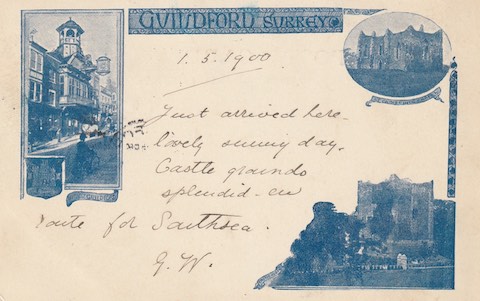
Above, an early topographical, otherwise known as view postcard, featuring Guildford’s Guildhall, the keep in the Castle Grounds and the ruined St Catherine’s chapel. And below the reverse side with a postmark of May 1, 1900. Note the cancellation stamp and the Queen Victoria stamp.
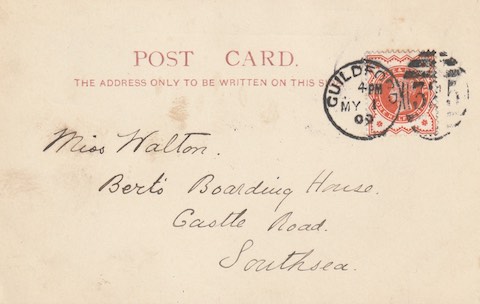
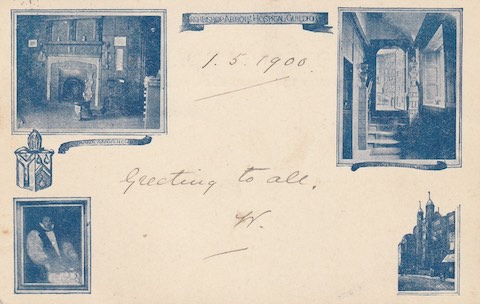
Above and below, the second postcard postmarked May 1, 1900, sent to the same person to the same address as the previous card. The images on this card relate to Abbot’s Hospital.
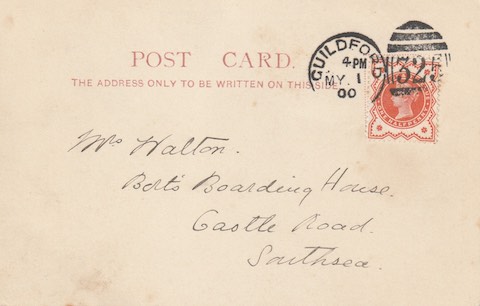
Another postcard, this time with much of the front of the card featuring an image, and with a number of words crammed in for the message is postmarked August 16, 1901.
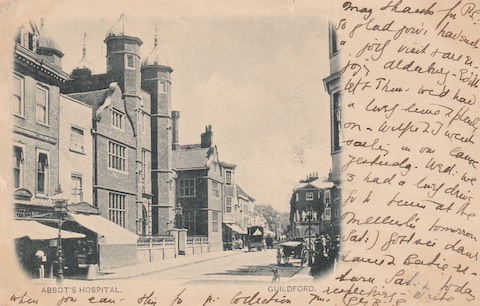
Above and below, the kind of postcard view that would soon become ubiquitous, but here on a card onto which the message had to be written on the same side as the image, it being Abbot’s Hospital. It is postmarked August 16, 1901.

Historic buildings appear to have caught the eye of these new postcard publishers. This must surely have followed in the wake of popular Victorian stereoscopic images – two images of the same scene, but taken from slightly different angles, with the left image presented to the left eye and the right image is presented to the right eye.
When viewed through a viewer or a pair of special glasses, the image appears as a single 3D view. Views of historic and well-known places were popular images to view by this method by the 19th-century middle classes.
Here is another “early” Guildford postcard, this one postmarked April 26, 1902.
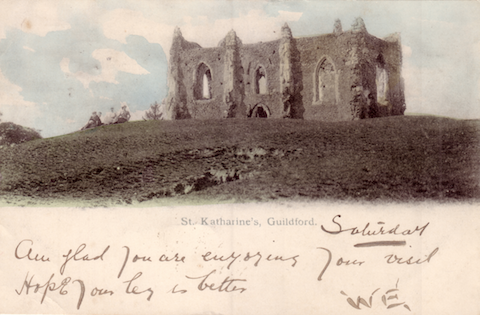
Above and below, the front and back of a postcard with a view of St Catherine’s Chapel, postmarked AP 26, 02.
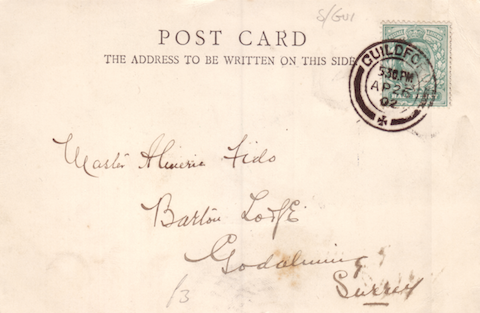
It was not until 1902 when what is known as the divided back was permitted – a postcard in which the address is written on the right and the message on the left, leaving the other side entirely for an image, although it seems they took a while to catch on. However, the floodgates of the picture postcard as we know it and the craze for not only sending and receiving them, but collecting them too, was well underway!
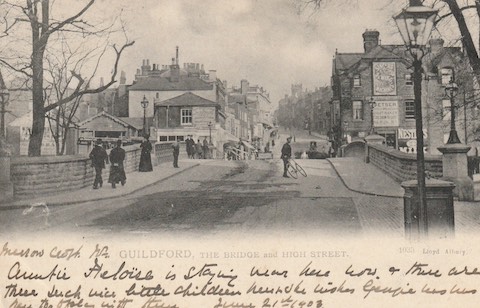
Above and below, this is an ‘undivided back’ postcard of Guildford’s then new Town Bridge (opened 1902),while postmarked July 21, 1903. It is a good example of the ‘everyday street scenes’ that were being photographed and published as picture postcards. The craze was underway!
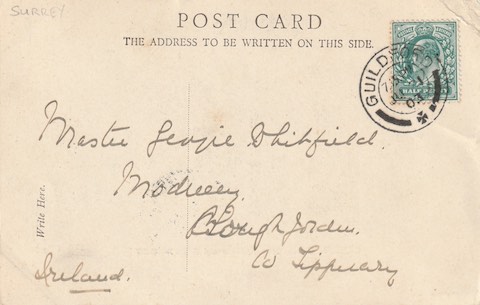
One of the publishers from the Guildford area who soon realised the potential of the topographical picture postcard was Albury’s postmaster Percy Lloyd. The two postcards seen above (St Catherine’s Chapel and Town Bridge) are among the scores of postcards he published with views of towns and villages, mainly in the local area.
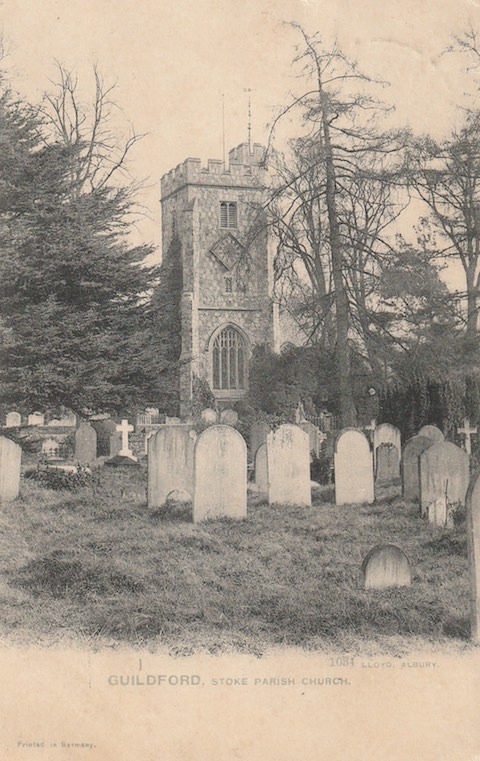
Above and below, the image on this card is horizontal with the back as a normal landscape. It is another by Percy Lloyd and features St John’s Church in Stoke Road, Guildford. Note the diagonal clock face. It appears it was changed a few years later. This card appears to be postmarked “No 17 04.” If that is correct, it is of course an “undivided back” card that was sent after messages were permitted on the same side as the address. Hence what the sender has done here! But perhaps there is some confusion. Although printed at the top is ‘THE ADDRESS TO BE WRITTEN ON THIS SIDE’ at the bottom left is printed ‘Write Here for inland only’.
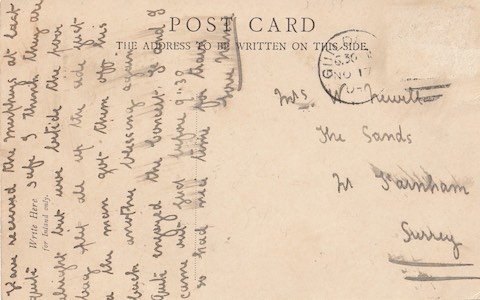
It is evident that Percy Lloyd was also an excellent photographer who knew how to compose delightful pictures of everyday scenes at the dawn of the 20th century.
The above postcard reveals that the “undivided back” certainly remained in use for a couple of years after – possibly older stock that was still in circulation, or postcards that had been bought previously and not sent until a later date, or that publishers and printers were slow to adopt the divided back.

Above and below, although this is an early divided back card (post 1902), the sender may have been under the impression they still had to write a short message only on the front. It is postmarked July 15, 1904. It features the keep of Guildford castle. The keep and the Castle Grounds would be photographed and issued as postcards time and time again from the 1900s onwards.
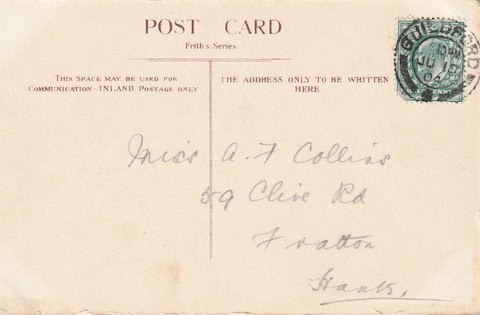
Also photographed and issued on picture postcards, even more than the Castle Grounds and without doubt any other view in Guildford, must surely have been the Guildhall in the High Street.
The view below shows a typical busy scene in the High Street and that famous clock! Even though there is a postmark on the card of October 12, 1904, who can say when the photograph was taken? Once published, the postcard may have gone through several reprints, or someone may have held on to it before they sent it.
And on many occasions postcards were not sent at all, as many people bought them to collect and keep for themselves.
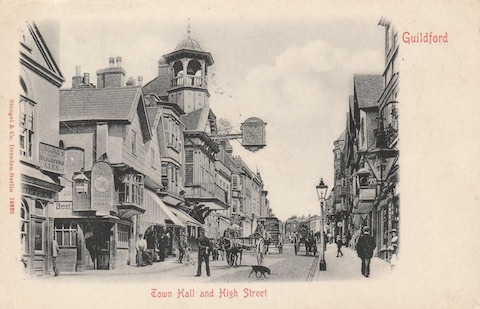
Above and below, the most photographed building in Guildford! An ‘undivided back’ card, but the sender didn’t bother to write a message.
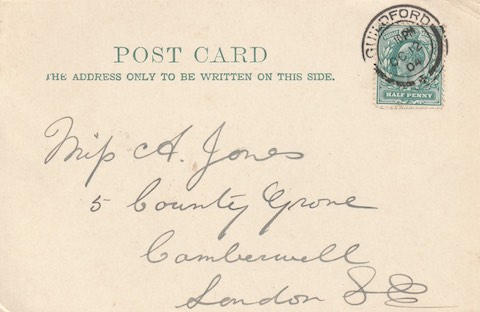
Responses to Searching for Guildford’s Earliest Picture Postcards
Leave a Comment Cancel replyPlease see our comments policy. All comments are moderated and may take time to appear.
Recent Articles
- Guildford Institute’s Crowdfunding Project for Accessible Toilet in its New Community and Wellbeing Centre
- Letter: Guildford – Another Opportunity Missed?
- Letter: GBC’s Corporate Strategy – Where Is the Ambition?
- My Memories of John Mayall at a Ground-breaking Gig in Guildford Nearly Six Decades Ago
- Westborough HMO Plans ‘Losing the Heart of the Street’ Says Resident
- College Invests to Boost Surrey’s Economy and Close Digital Skills Gap
- Community Lottery Brings Big Wins for Local Charities
- GBC Housing Plan Promises ‘A Vibrant Urban Neighbourhood’ Near Town Centre
- Hospital Pillows ‘Shortage’ at the Royal Surrey
- Updated: Caravans Set Up Camp at Ash Manor School


Recent Comments
- Ian Macpherson on Updated: Main Guildford to Godalming Road Closed Until August 1
- Sara Tokunaga on GBC Housing Plan Promises ‘A Vibrant Urban Neighbourhood’ Near Town Centre
- Michael Courtnage on Daily Mail Online Reports Guildford Has Highest-paid Council Officer
- Alan Judge on GBC Housing Plan Promises ‘A Vibrant Urban Neighbourhood’ Near Town Centre
- John Perkins on GBC Housing Plan Promises ‘A Vibrant Urban Neighbourhood’ Near Town Centre
- S Collins on GBC Housing Plan Promises ‘A Vibrant Urban Neighbourhood’ Near Town Centre
Search in Site
Media Gallery
Dragon Interview: Local Artist Leaves Her Mark At One of England’s Most Historic Buildings
January 21, 2023 / No Comment / Read MoreDragon Interview: Lib Dem Planning Chair: ‘Current Policy Doesn’t Work for Local People’
January 19, 2023 / No Comment / Read MoreA3 Tunnel in Guildford ‘Necessary’ for New Homes, Says Guildford’s MP
January 10, 2023 / No Comment / Read More‘Madness’ for London Road Scheme to Go Ahead Against ‘Huge Opposition’, Says SCC Leader
January 6, 2023 / No Comment / Read MoreCouncillor’s Son Starts Campaign for More Consultation on North Street Plan
December 30, 2022 / No Comment / Read MoreCounty Council Climbs Down Over London Road Works – Further ‘Engagement’ Period Announced
December 14, 2022 / No Comment / Read MoreDragon Interview: GBC Reaction to the Government’s Expected Decision to Relax Housing Targets
December 7, 2022 / No Comment / Read MoreHow Can Our Town Centre Businesses Recover? Watch the Shop Front Debate
May 18, 2020 / No Comment / Read More









Daniel Andrew
September 2, 2023 at 8:10 pm
Thank you, David Rose. I enjoy your articles very much.